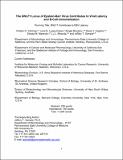The BHLF1 locus of Epstein-Barr virus contributes to viral latency and B-cell immortalization
Abstract
The Epstein-Barr virus (EBV) BHLF1 gene encodes an abundant linear and several circular RNAs believed to perform non-coding functions during virus replication, though an open reading frame is retained among an unknown percentage of EBV isolates. Evidence suggests that BHLF1 is also transcribed during latent infection, which prompted us to investigate the contribution of this locus to latency. Analysis of transcripts transiting BHLF1 revealed its transcription is widespread among B-cell lines supporting the latency I or III program of EBV protein expression, and to be more complex than originally presumed. EBV-negative Burkitt lymphoma cell lines infected with either wild-type or two different BHLF1 mutant EBVs were initially indistinguishable in supporting latency III. However, cells infected with BHLF1- virus ultimately transitioned to the more restrictive latency I, whereas cells infected with wild-type virus either sustained latency III or transitioned more slowly to latency I. Upon infection of primary B cells, which require latency III for growth in vitro, both BHLF1- viruses exhibited variably reduced immortalization potential relative to wild-type virus. Finally, in transfection experiments, efficient protein expression from an intact BHLF1 ORF required the EBV post-transcriptional regulator protein SM, whose expression is limited to the replicative cycle. Thus, one way in which BHLF1 may contribute to latency is through a mechanism, possibly mediated or regulated by a long non-coding RNA, that supports latency III critical for the establishment of EBV latency and lifelong persistence within its host, whereas any retained protein-dependent function of BHLF1 may be restricted to the replication cycle. Importance. Epstein-Barr virus (EBV) has significant oncogenic potential that is linked to its latent infection of B lymphocytes, during which virus replication is not supported. Establishment of latent infection, which is life long and can precede tumor development by years, requires the concerted actions of nearly a dozen EBV proteins and numerous small non-protein-coding RNAs. Elucidation of how these EBV products contribute to latency is crucial to understanding EBV's role in specific malignancies, and ultimately to clinical intervention. Historically, EBV genes that contribute to virus replication have been excluded from consideration of a role in latency, primarily because of the general incompatibility between virus production and cell survival. However, here we provide evidence that the genetic locus containing one such gene, BHLF1, indeed contributes to key aspects of EBV latency, including its ability to promote continuous growth of B lymphocytes, thus providing significant new insight into EBV biology and oncogenic potential.
Citation
Yetming , K D , Lupey-Green , L N , Biryukov , S , Hughes , D J , Marendy , E M , Miranda , J J L & Sample , J T 2020 , ' The BHLF1 locus of Epstein-Barr virus contributes to viral latency and B-cell immortalization ' , Journal of Virology , vol. Latest Articles , JVI01215-20 . https://doi.org/10.1128/JVI.01215-20
Publication
Journal of Virology
Status
Peer reviewed
ISSN
0022-538XType
Journal article
Description
Funding: U.S. Public Health Service grant AI110328 to J.T.S. and in part by Commonwealth Universal Research Enhancement (CURE) funds. L.N.L. received support from National Cancer Institute training grant T32 CA060395, and is a Lymphoma Research Foundation Grantee.Collections
Items in the St Andrews Research Repository are protected by copyright, with all rights reserved, unless otherwise indicated.

